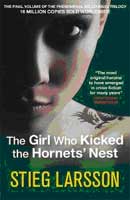
|
|
THE GIRL WHO KICKED THE HORNETíS NESTStieg LarssonQuercus pbk £7.99Released: April 1st 2010Reviewer: Ali Karim |
|
Ali Karim is assistant editor at SHOTS and writes/reviews for The Rap Sheet, January Magazine, Deadly Pleasures, Crimespree and Mystery Readers International |
|
There really is no point reading the third and final book in Larssonís Millennium Trilogy unless youíve read the first two Ė The Girl With The Dragon Tattoo and The Girl Who Played with Fire. These novels have become the biggest selling books of fiction in the world. In fact ,when The Girl Who Kicked the Hornetís Nest was released in paperback in the UK in April, the combined sales of the Larsson novels [in all their various editions] represented over 4% of total UK book sales that week. These three books have divided opinion, into those who love the tales of Lisbeth Salander and her male foil Mikael Blomkvist; and those who hate them. Reading this third volume without knowing the back story contained in the two preceding books would be akin to try and read this book in a Sanskrit edition, as much of the proceedings have their roots in the past. The other factor is that if you disliked the preceding books, then ĎHornetís Nestí will just annoy you, however if you loved the first two, then this will give you closure. So whatís the verdict on The Girl Who Kicked The Hornetís Nest? It is far more complex than the first two in terms of narrative direction, even more characters, many who are hard to delineate; though it is a treat for those who want to see closure after the traumatic incidents in the preceding books. It opens minutes from the conclusion of ĎFireí, with Salander seriously ill in hospital with gunshot wounds. Mikael Blomkvist tries to contact Salander despite a heavy police guard to try and unravel who she really us. Larsson uses the book to explore his two pet themes Ė violent misogyny against women, and the threat of the extreme right-wing to the stability of Swedish Democracy. In so doing we will discover what in Salanderís past resulted in her miss-fit persona, the seeds of which were sown in book two. Again the writing style is most peculiar but very hypnotic so the reader falls into a trance, engaged with the narrative, despite some convolution along the path of conspiracy. When I closed the book upon conclusion, a sense of melancholy spread over me like a thick blanket. I felt sad, because there would be no more tales about the adventures of Lisabeth Salander, and sadness came from the emptiness of losing a friend, even if she never really existed, except in the dark crevices of my imagination.
|

| Page By Gary Cane [Contact] | ||
| Webmaster: Tony 'Grog' Roberts [Contact] |